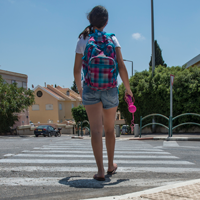5 Ways to Make Your Child’s School Zone Safer

Our newest research, “Alarming Dangers in School Zones,” done with support from FedEx, takes a closer look at dangers in school zones that could lead to injuries to students while walking to school. We found that about 80 percent of students observed did not cross the street safely. And some drivers are not being safe either. We observed that 1 in 3 drivers dropping off or picking up students displayed unsafe behaviors, like texting while driving or blocking the crosswalk. The research also includes information about the school zones themselves. Three out of 10 locations where students cross the street did not have a marked crosswalk. And only 4 out of 10 school zones had a speed limit of 20 mph or lower.
Here are some suggestions you can do as a parent to start making your child’s school zone safer. Start by walking your child’s route to school, or walk around the school zone, and ask yourself these questions:
- Does your school have a pick-up/drop-off policy?
- If your school doesn’t have a policy, print out this sample policies, or check out this completed policy from Kirk Elementary School. You can bring these to your school administrator to begin the discussion to develop a smart policy for your school. If your school already has a policy but it isn’t enforced, talk to the school administration about the importance of enforcing the policy. A little enforcement goes a long way.
- What’s your school’s speed limit?
- When a vehicle is traveling 20 mph, there is only a 10 percent likelihood of a severe injury or fatality to a pedestrian if there is a crash. At 40 mph, there is an 80 percent likelihood. This small change can save many lives.
- If your school zone’s speed limit is higher than 20 mph, first, contact your local Department of Transportation to find out what steps need to be taken in your community to change this. It varies from city to city, but the Department of Transportation can help you figure it out.
- Does your school have marked crosswalks?
- If your school zone doesn’t have marked crosswalks, talk to your local school administration and tell them it’s an important step for protecting kids. The school administration can work with the Department of Transportation to take the necessary steps to get crosswalks installed correctly and safely.
- Are there branches or bushes blocking signs or stoplights?
- If there are branches blocking signs on school property, contact the school maintenance department about trimming back the branches or bushes so drivers can see the signs.
- Does your school have signage with safety messaging about distraction?
- Download and print these free signs that remind walkers and drivers to keep their heads up and phones down. You can put these in the grass around the school or hang them where students might be walking.
